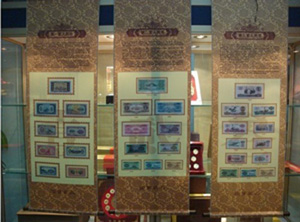National Treasure Collection: The First, Second, and Third Series of Renminbi Collectibles
The Renminbi (RMB) holds an important position in the history of China's currency culture. It is the legal tender of our country. Apart from the fourth and fifth series currently in circulation, all other banknote varieties have completed their specific historical missions and have completely exited the circulation domain. As works of art and collectibles, they possess another special function — investment value in collecting. "Discontinued in circulation" RMB becomes a special collectible adhering to the principle of "rarity makes it valuable." To meet the needs of a wide range of collectors, we have gone through great efforts to collect some old version RMB notes. We are proud to introduce "National Treasure Collection" — the first, second, and third series of RMB banknotes.
The first series of RMB was issued starting December 1, 1948, as the Liberation War advanced victoriously. The circulation area of RMB grew larger, and the number of denominations increased. It was issued until December 1953, with a total of 12 different denominations. This set of RMB is diverse in types and complex in versions, with the largest denomination being the ten-thousand yuan note, setting a record for the largest RMB denomination ever (a rare treasure).
The "National Treasure Collection" gathers 9 notes from the first series: Ten-thousand Yuan (King of Banknotes), Five-thousand Yuan, One-thousand Yuan, Five-hundred Yuan, Two-hundred Yuan, One-hundred Yuan, Fifty Yuan, Twenty Yuan, and Ten Yuan.
The second series of RMB was issued from March 1955 to April 1962, with a total of 11 denominations including 1 fen, 2 fen, 5 fen, 1 jiao, 2 jiao, 5 jiao, 1 yuan, 2 yuan, 3 yuan, 5 yuan, and 10 yuan notes. The second series has fewer versions, smaller denominations, higher unit values, and is convenient for circulation. Due to insufficient domestic printing technology and capacity at that time, and the lack of high-quality specialized banknote paper, the 3 yuan, 5 yuan, and 10 yuan notes were designed domestically but printed by the former Soviet Union, hence referred to as the Soviet-printed "three tickets." Among them, the 3 yuan note is the only one of its kind issued in China so far (commonly known as the King of Banknotes).
The "National Treasure Collection" gathers 10 notes from the second series: 5 yuan, 3 yuan (King of Banknotes), 2 yuan, 1 yuan, 5 jiao, 2 jiao, 1 jiao, 5 fen, 2 fen, and 1 fen.
The third series of RMB was issued on April 20, 1960, with seven denominations and thirteen versions including 1 jiao, 2 jiao, 5 jiao, 1 yuan, 2 yuan, 5 yuan, and 10 yuan. The 1960 edition red-brown 1 jiao note issued on April 20, 1962, was the earliest issued version. On January 10, 1966, the 1962 edition 1 jiao note was issued, with green ink on both sides of the chrysanthemum design on the back, commonly known as the "back-green note" (the red-brown 1 jiao note is commonly known as the "Chinese Coin King," and the back-green 1 jiao note is commonly known as the "Chinese Banknote King").
The "National Treasure Collection" gathers 12 notes from the third series: 10 yuan, 5 yuan, 2 yuan, 1 yuan, 5 jiao, 2 jiao, 1 jiao, 5 fen, 2 fen, 1 fen, red-brown 1 jiao, and back-green 1 jiao.
Chinese banknotes, as a uniquely charming cultural medium, have risen rapidly in the field of coin collection, attracting more and more collectors' attention. Collecting Chinese banknotes represents a refined taste and an embodiment of investment in collecting. Through the collection, appreciation, and study of banknotes, RMB banknotes, which have completely exited the circulation domain, serve as works of art and collectibles, possessing another special function — investment value in collecting.
In view of this, the China Collectibles Authentication Center and the China Collectors Investment Association have decided to ensure the authority and authenticity of this collection by supervising the entire process of compiling the "National Treasure Collection." A limited edition of 188 sets will be issued, with a unified collection price of 59,000 yuan.
